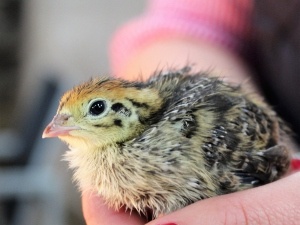
A good quail chick raiser will do all that they can to make sure that their bird lives a healthy and happy life, and this sometimes means dealing with any health issues that may come up.
This article looks into some of the problems your quail chick may develop at its feet.
Table of Contents
Quail chick feet problems:
The feet are one of the most important parts of a bird, without them, movement is not possible, so, it’s important to make sure that your bird’s feet are in good condition at all times.
Here are conditions to look out for that may cause problems in your bird’s feet:
Curly toe paralysis:
Curly toe paralysis is one of the conditions that you should look out for if you’re raising baby quail chicks.
This condition causes your baby bird’s toes to curl inwards making it very difficult for the bird to walk.
A bird that has difficulty walking will eventually starve to death because the bird isn’t able to eat when it needs to eat.
Your bird may develop this condition if it has a vitamin B2 deficiency or as a symptom of Marek’s disease.
What to do:
Supplementing the bird’s feed with vitamin B2 would be the first thing to do, this will get rid of the deficiency.
Giving your birds a supplement, that contains vitamin D3, Vitamin B2, Vitamin E, calcium, manganese, and phosphorus, is also recommended as these promote bone formation.
Your baby quail’s bones will strengthen as it gets older so making a sandal for the bird will help the bones set in the correct position. You can make these out of tape and cardboard.
What may also help is making food easier to access while the bird is still recovering
Spraddle leg:
Spraddle leg is the second condition that you should look out for in baby quail. This condition causes your bird’s legs to splay out causing the bird to sit on its bottom instead of standing on its legs.
It can be caused by slippery floorings, like newspaper in the brooder, temperature fluctuations during incubation, brooder overcrowding, a vitamin deficiency, and weak legs because of a difficult hatch.
What to do:
Get the birds off of the slippery newspaper floor and leave paper towels or rubber shelf liners at the bottom of the brooder.
Keep this from happening in the future by making sure that the incubator temperature settings stay constant.
Injury:
Your little quail chick may try to act as though it can’t be injured but the truth is the bird can become injured quite easily.
Injuries to the legs usually happen when a bird falls, is attacked, or fights with another bird.
Leg injuries can be minor or severe, but, in both cases, the bird will try its best to mask signs of injury.
Your bird will likely try to hide any signs of injury so you’d need to have a keen eye if you’re raising these birds.
What to do:
The first step when dealing with an injured baby quail chick is to stay calm, this will keep the bird calm and keep it from injuring itself even more
Depending on how severe the injury is you can either treat the bird’s leg injury at home, or, take the bird to the vet to be treated.
If you enjoyed this article then you may also be interested in other bird related articles. Here are some articles that you may be interested in: Baby Chickens Vibrating, Baby Chick Cries When Pooping, Quail Chick Not Growing, Quail Chick Leg Problems, Day Old Chick Not Eating, 5 Day Old Chick Not Eating, 2 Week Old Chick Not Eating, Lethargic Quail Chick, Baby Chick Not Moving Much

